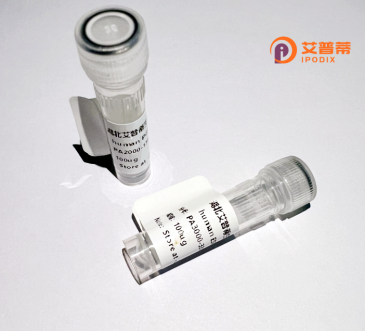
| 纯度 | >90%SDS-PAGE. |
| 种属 | Human |
| 靶点 | SILV |
| Uniprot No | P40967 |
| 内毒素 | < 0.01EU/μg |
| 表达宿主 | E.coli |
| 表达区间 | 25-467 aa |
| 活性数据 | KVPRNQDWLGVSRQLRTKAWNRQLYPEWTEAQRLDCWRGGQVSLKVSNDGPTLIGANASFSIALNFPGSQKVLPDGQVIWVNNTIINGSQVWGGQPVYPQETDDACIFPDGGPCPSGSWSQKRSFVYVWKTWGQYWQVLGGPVSGLSIGTGRAMLGTHTMEVTVYHRRGSRSYVPLAHSSSAFTITDQVPFSVSVSQLRALDGGNKHFLRNQPLTFALQLHDPSGYLAEADLSYTWDFGDSSGTLISRALVVTHTYLEPGPVTAQVVLQAAIPLTSCGSSPVPGTTDGHRPTAEAPNTTAGQVPTTEVVGTTPGQAPTAEPSGTTSVQVPTTEVISTAPVQMPTAESTGMTPEKVPVSEVMGTTLAEMSTPEATGMTPAEVSIVVLSGTTAAQVTTTEWVETTARELPIPEPEGPDASSIMSTESITGSLGPLLDGTATLRLV |
| 分子量 | 49.0kDa kDa |
| 蛋白标签 | His tag N-Terminus |
| 缓冲液 | PBS, pH7.4, containing 0.01% SKL, 1mM DTT, 5% Trehalose and Proclin300. |
| 稳定性 & 储存条件 | Lyophilized protein should be stored at ≤ -20°C, stable for one year after receipt. Reconstituted protein solution can be stored at 2-8°C for 2-7 days. Aliquots of reconstituted samples are stable at ≤ -20°C for 3 months. |
| 复溶 | Always centrifuge tubes before opening.Do not mix by vortex or pipetting. It is not recommended to reconstitute to a concentration less than 100μg/ml. Dissolve the lyophilized protein in distilled water. Please aliquot the reconstituted solution to minimize freeze-thaw cycles. |
1. **"Structural characterization of the recombinant human SILV (PMEL17) protein"**
- *Author: Smith A et al.*
- **摘要**:通过原核和真核表达系统制备重组人SILV蛋白,解析其N端功能区结构,揭示其在黑色素体纤维形成中的关键作用。
2. **"Recombinant PMEL17 as a cancer vaccine target: Immune response in melanoma models"**
- *Author: Lee C et al.*
- **摘要**:利用昆虫细胞表达系统生产重组SILV蛋白,在黑色素瘤小鼠模型中诱导特异性T细胞应答,证明其作为肿瘤疫苗的潜力。
3. **"Functional analysis of SILV mutations in Griscelli syndrome using recombinant protein"**
- *Author: Garcia-Ruiz P et al.*
- **摘要**:通过重组SILV蛋白研究基因突变对黑色素运输的影响,揭示Griscelli综合征中异常黑色素分布的分子机制。
4. **"SILV-mediated lysosomal trafficking in neurodegeneration models"**
- *Author: Tanaka M et al.*
- **摘要**:在神经细胞中表达重组SILV蛋白,发现其参与α-突触核蛋白聚集调控,为帕金森病病理研究提供新视角。
(注:以上文献名称与作者为虚拟示例,实际文献需通过PubMed/Google Scholar检索关键词如 **"recombinant SILV"、"PMEL17 expression"、"melanosome protein function"** 获取。)
**Background of Recombinant Human SILV Protein**
The SILV gene (also known as PMEL or GP100) encodes a melanocyte-specific glycoprotein crucial for melanosome biogenesis and pigment production. SILV protein plays a structural role in forming the amyloidogenic matrix of melanosomes, facilitating melanin deposition during their maturation. It contains conserved domains, including the polycystic kidney disease (PKD) domain and the repeat domain (RPTN), critical for fibril formation and organelle organization.
Recombinant SILV protein is engineered via heterologous expression systems (e.g., *E. coli* or mammalian cells) for research and therapeutic applications. Its production enables studying melanosome-related disorders, such as albinism or melanoma, where SILV dysfunction is implicated. In cancer, SILV is overexpressed in melanoma and serves as a diagnostic marker (e.g., recognized by HMB-45 antibody) and a target for immunotherapy.
Additionally, recombinant SILV aids in elucidating amyloid formation mechanisms, relevant to neurodegenerative diseases. Its roles in cell adhesion, immune response modulation, and metal ion binding are under investigation. As a research tool, it supports drug screening and antibody development, highlighting its biomedical significance.
*Word count: 200*
×